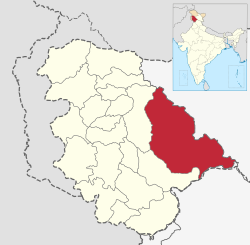Kishtwar District
| Kishtwar district | |
|---|---|
| District | |
 Location in Jammu and Kashmir, India |
|
| Coordinates: 33°18′46″N 75°46′10″E / 33.312683°N 75.769447°ECoordinates: 33°18′46″N 75°46′10″E / 33.312683°N 75.769447°E | |
| Country |
|
| State | Jammu and Kashmir |
| Headquarters | Kishtwar |
| Area | |
| • Total | 7,824 km2 (3,021 sq mi) |
| Population (2011) | |
| • Total | 230,696 |
| • Density | 29/km2 (76/sq mi) |
| Languages | |
| • Official | Urdu |
| Time zone | IST (UTC+5:30) |
| Website | http://kishtwar.nic.in |
'Kishtwar is a beautiful remote and highly mountainous district of the state of Jammu and Kashmir of India. It is among the ten districts of Jammu Division of J & k state. As of 2011, it is the third least populous district of Jammu and Kashmir (out of 22), after Kargil and Leh. Being rich in water resources and capacity of Hydroelectric Power generation It has highest wattage production in the world for such a small area. The headquarters of District is located in Kishtwar town about 230 Kilometers from Winter capital Jammu and 180 Km from summer capital Srinagar. The district is vast in area and borders with Ladakh and Himachal Pradesh on eastern side , Doda on western side , Anantnag on northern side and Gandoh, Thatri, on southern side. The famous Kishtwar National Park located at Tehsil Dachhan is 26 Kilometers from District headquarters. The district was created in the year 2007 as per SRO 185 of 2007 by the G N Azad government. It has four sub divisions Kishtwar , Padder, Chatroo and Marwah and eleven Tehsils. There are total 156 Revenue villages out of which one namely DharBhangar in Tehsil Drabshala is uninhabited. The administration is headed by Deputy Commissioners and police is headed by Senior Superintendent of police. Kishtwar sub division is headed by Assistant Commissioner revenue whereas other three sub divisions are headed by Sub Divisional Magistrates SDM. The mini Secretariat complex at Kuleed in village Lachhdayaram houses the offices of District level officers except PWD, PDD, PHE, Labour and Employment, and RDD who have their own offices. The judiciary is headed by Principal District and session judge. The district has all villages except Village Kishtwar registered as Backward Area under SRO 294. The main language spoken is Pahari dialect of Kashmiri followed by many regional languages such as padegi, Bhaderwahi, pashto, gojri, Kishtwari and Urdu. The official language of record is Urdu but English is the main medium of communication. Being an old principality the District has rich cultural heritage and in 1821 after annexation by Lahore durbar and later by Dogra Raj it was reduced to a small Tehsil of Udhampur District till 1948 when it was made part of erstwhile district Doda. The District has few source of employment and main occupation is service sector about 5℅ population is engaged in regular or ad-hoc government service while rest is dependent on agriculture and livestock. There is a well knit road network and every Tehsil except Dachhan and Machail has road connectivity. The Sub division marwah is unelectrified and efforts are on to electrify the whole district. It's Famous For World Renowned Sapphire & Saffron. Also a large amount of Beans and walnut , and Morchila are also produced in the district. The meadows are rich in wild grass and the nomadic tribes of Bakrwals and Gaddi visit the district to graze their cattle during summers. Kishtwar has a small airport at the northern edge of meadow ground named Chowgan however runway has not been made functional after it was left so by the French company DSB in the year 1991. The airport is used for helicopter rides by the choppers of army which airlift peoe of marwah during winter season as the roads remains blocked due to heavy snowfall. The town is main business hub and also the base camp for travel to other places of state. Road connectivity is only link with the outside world and highly danger Kishtwar Batote National 1A connects Kishtwar district with India. The Kishtwar Synthan National Highway connects with Srinagar and Kishtwar Dool Galhar Sansari road connects with the pangi Tehsil of Himachal Pradesh. The Padder Tehsil produce chilgoze pines. River chenab is main river which flows in deep gorges and due to difficult terrain the water is neither used for irrigation nor drinking leaving the district with literally washing the feet but keeping lips thirsty.
...
Wikipedia
